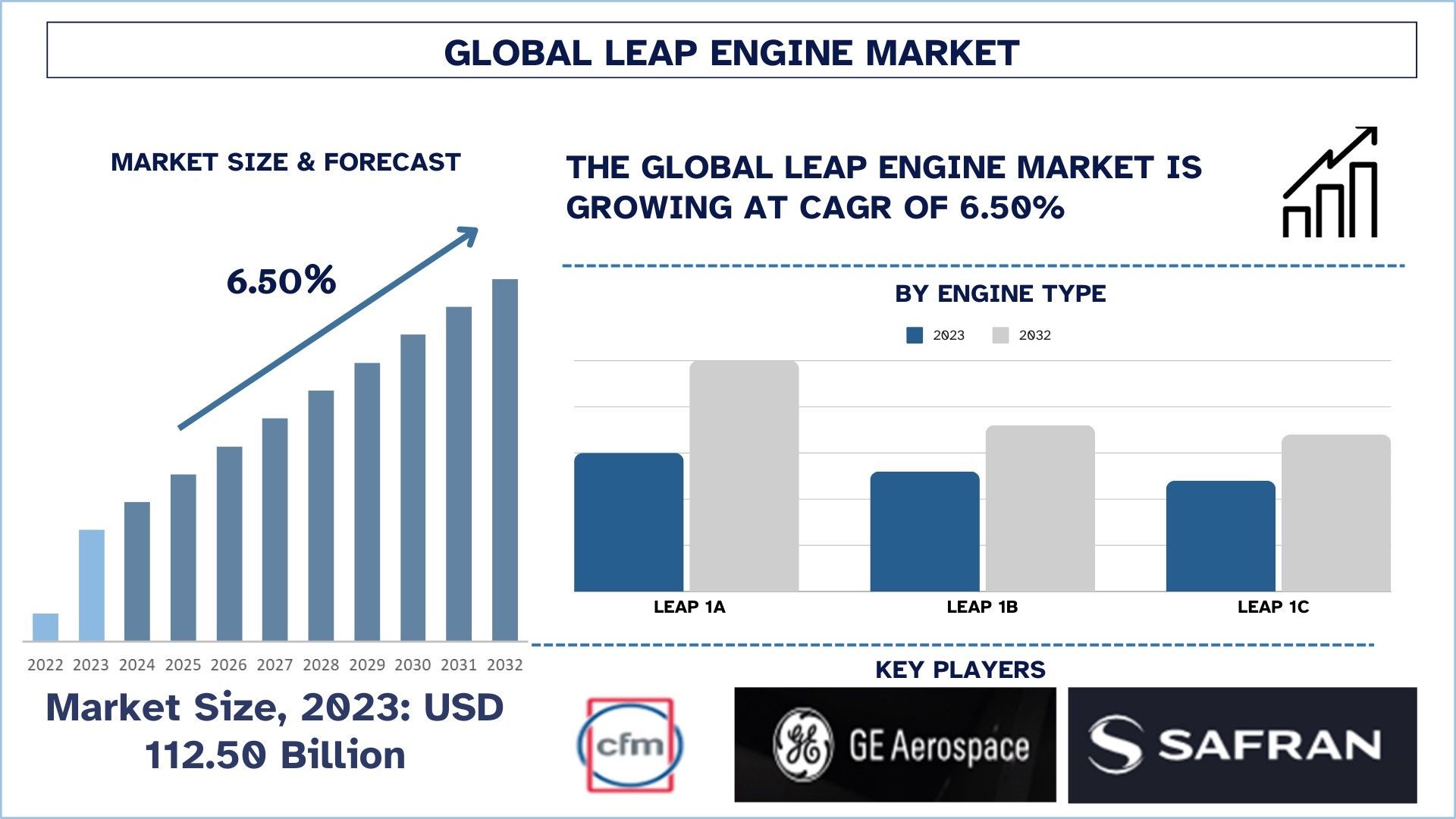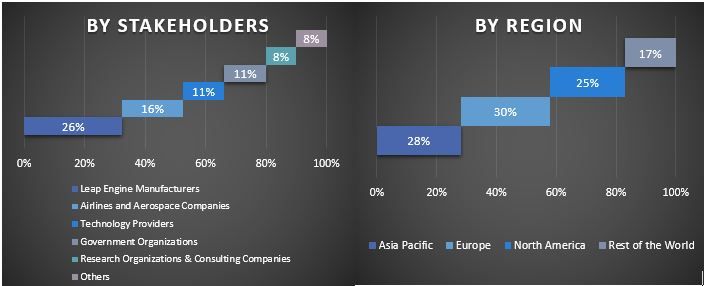- Home
- About Us
- Industry
- Services
- Reading
- Contact Us
Leap Engine Market: Current Analysis and Forecast (2024-2032)
Emphasis on Engine Type (LEAP 1A, LEAP 1B, and LEAP 1C); Application (Commercial, Business and Others); and Region/Country

Leap Engine Market Size & Forecast
The leap engine market was valued at approximately USD 112.50 billion in 2023 and is expected to grow at a considerable CAGR of around 6.50% during the forecast period (2024-2032) owing to the surge in air travel, demand for more reliable and fuel-efficient engines and growing environmental regulations.
Leap Engine Market Analysis
Leap engines offer greater fuel efficiency compared to previous-generation engines. The leap engine has maintained 15% to 20% improved fuel efficiency to date, which is a major factor that attracts the airlines. Major airline companies in the world are modernizing their fleets and adopting leap engines to reduce operational costs and increase their market presence. For instance, in July 2024, Macquarie AirFinance finalized an agreement for 20 Boeing 737 MAX aircraft powered by 40 LEAP-1B engines. The company manages a fleet of more than 160 CFM-powered aircraft in service today, including both CFM56-powered Boeing 737NG and Airbus A320ceo family aircraft and LEAP-powered 737 MAX 8 and A320neo aircraft. Additionally, the growing environmental regulations to reduce CO2 emissions have fueled the demand for leap engines. As per the report published by CFM International, there were more than 3300 leap engines in service which has saved the outflow of more than 35 million tons of CO2 emissions. The engine is one of the most advanced and powerful products in the history of 50 years of CFM International. Therefore, with greater adoption of this engine by airlines the market is set to experience substantial growth in the forecast period.
Recent Developments in the Market:
In April 2024, CFM International developed and delivered LEAP-1A engines outfitted with its new reverse bleed system (RBS) to Airbus. The LEAP-1A engine with a new RBS system, which mitigates carbon build-up on fuel nozzles, was certified by the FAA and EASA in 2023. As a result, the requirement for on-wing fuel nozzle replacement and associated maintenance burden will be dramatically reduced.
In March 2024, American Airlines, one of the world’s largest airlines finalized various agreements with CFM International for LEAP-1B engines to power the airline’s Boeing 737 MAX 8 and MAX 10 fleet. The agreement includes the purchase of spare engines, including a new 20-year service agreement covering America’s existing and new LEAP-1B engines.
Leap Engine Market Trends
AI-Driven Predictive Maintenance
One of the major trends arising in the leap engine market is the rising demand for AI-driven predictive maintenance. In today's world, AI has become paramount for various industries including aerospace and defense, which improves engine performance, reduces downtime, and increases the life span of leap engines. For instance, in February 2024, Lufthansa Systems introduced its new cutting-edge AI-powered operations control assistant for the airline industry. NetLine/Ops ++ aiOCC is a web-based AI assistant that supports airline operations controllers in increasing the stability and efficiency of daily operations. The solution is already in use and jointly optimized with the first customers. Additionally, companies operating in the market are investing hefty amounts for the upgradation in predictive maintenance. For example, in 2024, GE is integrating AI into preventive maintenance for jet engines, aiming to cut unscheduled removals by one-third. Developed at GE’s Bengaluru center, the AI-based “Digital Twin” system uses image analytics to predict failures and prioritize maintenance. Therefore, AI-driven predictive maintenance is reshaping the leap engine market.

North America is expected to dominate the market during the forecast period
North America held the majority share of the market in the year 2023. The major factors contributing to the growth of the market include the strong presence of major airlines that are continuously modernizing their fleet. Additionally, Boeing one of the major aerospace companies, being headquartered in the United States covered a significant market share in the region, which has boosted the market. Boeing has received commitments for approximately 600 additional aircraft, for a total of 1,400 engines. Furthermore, some of the common factors that boosted the demand for the market include the rising disposable income, the growth of low-cost carriers, and the growing environmental regulations. For instance, in July 2024, Nordic Aviation Capital (NAC), a global leader in aircraft leasing, today announced an order for ten LEAP-1A engines to power five Airbus A321neo family aircraft. The agreement also includes options for two additional LEAP-powered A321neo family aircraft. Thus, amongst areas, North America held a significant share of the market in the year 2023.

Leap Engine Industry Overview
The leap engine market is competitive, with several global and international market players. The key players are adopting different growth strategies to enhance their market presence, such as partnerships, agreements, collaborations, geographical expansions, and mergers and acquisitions. Some of the major players operating in the market are CFM International, General Electric Company, and Safran S.A.
Leap Engine Market Report Coverage
Report Attribute | Details |
Base year | 2023 |
Forecast period | 2024-2032 |
Growth momentum | Accelerate at a CAGR of 6.50% |
Market size 2023 | USD 112.50 billion |
Regional analysis | North America, Europe, APAC, Rest of the World |
Major contributing region | North America is expected to dominate the market during the forecast period. |
Key countries covered | The US, Canada, Germany, United Kingdom, Spain, Italy, France, China, Japan, and India |
Companies profiled | CFM International, General Electric Company, and Safran S.A. |
Report Scope | Market Trends, Drivers, and Restraints; Revenue Estimation and Forecast; Segmentation Analysis; Demand and Supply Side Analysis; Competitive Landscape; Company Profiling |
Segments Covered | By Engine Type; By Application; By Region/Country |
Reasons to buy this report:
The study includes market sizing and forecasting analysis validated by authenticated key industry experts.
The report presents a quick review of overall industry performance at one glance.
The report covers an in-depth analysis of prominent industry peers with a primary focus on key business financials, product portfolios, expansion strategies, and recent developments.
Detailed examination of drivers, restraints, key trends, and opportunities prevailing in the industry.
The study comprehensively covers the market across different segments.
Deep dive regional level analysis of the industry.
Customization Options:
The global leap engine market can further be customized as per the requirement or any other market segment. Besides this, UMI understands that you may have your own business needs, hence feel free to contact us to get a report that completely suits your requirements.
Table of Content
Research Methodology for the Leap Engine Market Analysis (2024-2032)
Analyzing the historical market, estimating the current market, and forecasting the future market of the global leap engine market were the three major steps undertaken to create and analyze the adoption of leap engines in major regions globally. Exhaustive secondary research was conducted to collect the historical market numbers and estimate the current market size. Secondly, to validate these insights, numerous findings and assumptions were taken into consideration. Moreover, exhaustive primary interviews were also conducted, with industry experts across the value chain of the global leap engine market. Post assumption and validation of market numbers through primary interviews, we employed a top-down/bottom-up approach to forecasting the complete market size. Thereafter, market breakdown and data triangulation methods were adopted to estimate and analyze the market size of segments and sub-segments of the industry pertains to. Detailed methodology is explained below:
Analysis of Historical Market Size
Step 1: In-Depth Study of Secondary Sources:
A detailed secondary study was conducted to obtain the historical market size of the leap engine market through company internal sources such as annual reports & financial statements, performance presentations, press releases, etc., and external sources including journals, news & articles, government publications, competitor publications, sector reports, third-party database, and other credible publications.
Step 2: Market Segmentation:
After obtaining the historical market size of the leap engine market, we conducted a detailed secondary analysis to gather historical market insights and share for different segments & sub-segments for major regions. Major segments are included in the report, such as engine type, application, and region. Further country-level analyses were conducted to evaluate the overall adoption of testing models in that region.
Step 3: Factor Analysis:
After acquiring the historical market size of different segments and sub-segments, we conducted a detailed factor analysis to estimate the current market size of the leap engine market. Further, we conducted factor analysis using dependent and independent variables such as engine type, application, and regions of the leap engine market. A thorough analysis was conducted of demand and supply-side scenarios considering top partnerships, mergers and acquisitions, business expansion, and product launches in the leap engine market sector across the globe.
Current Market Size Estimate & Forecast
Current Market Sizing: Based on actionable insights from the above 3 steps, we arrived at the current market size, key players in the global leap engine market, and market shares of the segments. All the required percentage shares split and market breakdowns were determined using the above-mentioned secondary approach and were verified through primary interviews.
Estimation & Forecasting: For market estimation and forecast, weights were assigned to different factors including drivers & trends, restraints, and opportunities available for the stakeholders. After analyzing these factors, relevant forecasting techniques i.e., the top-down/bottom-up approach were applied to arrive at the market forecast for 2032 for different segments and sub-segments across the major markets globally. The research methodology adopted to estimate the market size encompasses:
- The industry’s market size, in terms of revenue (USD) and the adoption rate of the leap engine market across the major markets domestically.
- All percentage shares, splits, and breakdowns of market segments and sub-segments.
- Key players in the global leap engine market in terms of products offered. Also, the growth strategies adopted by these players to compete in the fast-growing market.
Market Size and Share Validation
Primary Research: In-depth interviews were conducted with the Key Opinion Leaders (KOLs) including Top Level Executives (CXO/VPs, Sales Head, Marketing Head, Operational Head, Regional Head, Country Head, etc.) across major regions. Primary research findings were then summarized, and statistical analysis was performed to prove the stated hypothesis. Inputs from primary research were consolidated with secondary findings, hence turning information into actionable insights.
Split of Primary Participants in Different Regions

Market Engineering
The data triangulation technique was employed to complete the overall market estimation and to arrive at precise statistical numbers for each segment and sub-segment of the global leap engine market. Data was split into several segments and sub-segments after studying various parameters and trends in the areas of engine type, application, and regions in the global leap engine market.
The main objective of the Global Leap Engine Market Study
The current & future market trends of the global leap engine market were pinpointed in the study. Investors can gain strategic insights to base their discretion for investments on the qualitative and quantitative analysis performed in the study. Current and future market trends determined the overall attractiveness of the market at a regional level, providing a platform for the industrial participant to exploit the untapped market to benefit from a first-mover advantage. Other quantitative goals of the studies include:
- Analyze the current and forecast market size of the leap engine market in terms of value (USD). Also, analyze the current and forecast market size of different segments and sub-segments.
- Segments in the study include areas of the engine type, application, and regions.
- Define and analyze the regulatory framework for the leap engine
- Analyze the value chain involved with the presence of various intermediaries, along with analyzing customer and competitor behaviors of the industry.
- Analyze the current and forecast market size of the leap engine market for the major region.
- Major countries of regions studied in the report include Asia Pacific, Europe, North America, and the Rest of the World
- Company profiles of the leap engine market and the growth strategies adopted by the market players to sustain in the fast-growing market.
- Deep dive regional level analysis of the industry.
Frequently Asked Questions FAQs
Q1: What is the leap engine market's current market size and growth potential?
The leap engine market was valued at USD 112.50 Billion in 2023 and is expected to grow at a CAGR of 6.50% during the forecast period (2024-2032).
Q2: What are the driving factors for the growth of the leap engine market?
The surge in air travel, demand for more reliable and fuel-efficient engines, and growing environmental regulations are driving the leap engine market.
Q3: Which segment has the largest share of the leap engine market by engine type?
The LEAP 1A segment has the largest share of the leap engine market by engine type.
Q4: What are the emerging technologies and trends in the leap engine market?
The adoption of AI-driven predictive maintenance is one of the major trends in the leap engine market.
Q5: Which region will dominate the leap engine market?
North America is expected to dominate the market during the forecast period.
Related Reports
Customers who bought this item also bought










